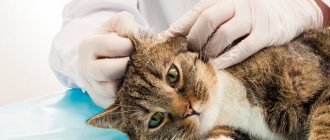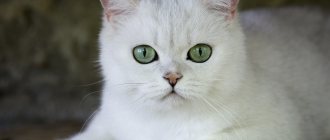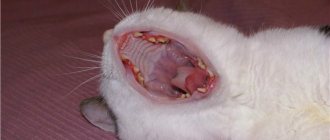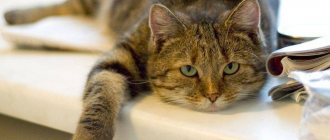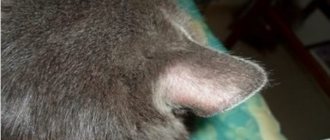When we get pets, particularly cats, we must remember that health is a very important aspect. A living creature requires attention and care. And how you care for your cat will determine its vital activity. It's good when the cat is energetic, has an excellent appetite and there are no signs that something is wrong with it. But if you suddenly notice that your pet has begun to behave differently, something is bothering her, she has become less active, and is not eating well, then this means that not everything is in order with her health and something needs to be done. The first thing is to observe how often the cat begins to go to the toilet in small ways. Perhaps this is the essence of such changes in her behavior.
Healthy cat
Frequent visits to the litter box may be a warning sign that your pet is sick. It is considered normal if a cat goes to the toilet 2-3 times a day. This should be quite enough for her. At the same time, the process of urination does not cause her any discomfort. Urine is light yellow or orange in color and does not have a pungent or unpleasant odor. The most innocuous reason for a cat to pee frequently is that it is drinking large amounts of water, perhaps because it is hot or because it has eaten salty food. Old age may also be the cause of frequent urge to go to the toilet. With age, muscles weaken and urine retention becomes weaker. In these cases, there is no reason for great excitement.
Causes not directly related to the disease
Infectious diseases and inflammation of internal organs are not always the reason why a cat often visits the litter box. This is especially true for kittens and young animals under the age of one year, since cystitis occurs extremely rarely in them. So, there are several possible reasons for frequent visits to the toilet that are not related to infection or inflammation:
- Stressful situation.
- Intense thirst.
- Marking the territory.
Below, all of these problems are discussed in more detail.
The cat pees often
But what if the reason is not in drinking a large amount of liquid or in old age? Then why does the cat pee often? Perhaps something is bothering her, and in this way she is trying to draw attention to herself and what hurts her. Don't punish her. Show understanding and increased care towards it, because the animal cannot say what exactly is bothering it, and is not able to help itself. First, watch your cat closely. If her general condition does not indicate that she may be sick with something, then the reason must be sought in her psychology. But if you notice that your pet has become lethargic and weak, its urine has an unpleasant odor, it contains purulent or bloody discharge, it becomes dark or cloudy in color, if you notice that the process of urination causes pain, then it’s time to sound the alarm - your cat is seriously ill. In this case, the sooner you determine what’s wrong with your pet and begin treatment, the better for his health and life.
Territory designation
At the age of 6-8 months, cats reach puberty, and the reproductive instinct makes itself felt with characteristic signs: loud meowing and guttural screams, changes in behavior (excessive affection or aggressiveness), as well as marking of territory. Urine is used by animals as a way to attract a mate and let him know that they are willing to mate.
The soiling of furniture, curtains, clothes, the owner's slippers and other household items indicates that sexual hunting has begun. By means of secreted pheromones, females notify males that they are ready to reproduce, and males scare away other cats, letting them know that entry into someone else’s territory is prohibited. The marking process goes like this: the animal approaches a vertical surface (wall, door, furniture) with its back, raises its tail and leaves stinking marks on the surface with stunning movements.
It is useless to go against nature, so no educational measures or persuasion will help to reason with the cat so that he does not pee anywhere. In such a situation, three options are possible:
- Realize natural instinct and mate animals. It makes sense when there is an opportunity to place the kittens in good hands in the future or sell them if the parents are purebred. It is worth considering that frequent mating undermines the health of cats, and cats only temporarily stop marking the apartment.
- Castration/sterilization. A surgical solution to the problem is a fairly common method of contraception. The operation involves the removal of the gonads and, as a result, the animal’s sexual activity is suppressed or completely stopped. It is performed under general anesthesia in a veterinary clinic. After surgery, you will no longer need to try to wean your cat from peeing in the wrong place - they lose interest in the opposite sex, become obedient, affectionate and do not mark in the house.
- Taking hormonal drugs. There are many pros and cons for this method, so the decision to use oral contraceptives is made individually by the cat owner. Sterilization surgery may be contraindicated due to the animal’s advanced age, various injuries and health problems.
Important: it should be borne in mind that hormonal drugs can cause the development of mastopathy and malignant tumors. As an alternative, veterinarians suggest bio-sterilization, that is, a one-time injection of hormones into the cat’s body. The procedure lasts for 9-12 months, and then it is repeated again.
Possible diseases
There are several diseases, a symptom of which may be that the cat pees very often and little. These are diseases of the genitourinary system. Some of them can be very insidious. What disease your cat has can be determined, of course, only by a veterinarian after examination and passing all the necessary tests. It is strongly not recommended to engage in treatment or give any medications on your own without a doctor’s prescription, without even knowing what happened to your cat. Your pet may only get worse and you will waste time.
Diagnosing the problem
You can try to determine the cause of frequent urination yourself, but this is not the best solution, because being a non-professional, you can miss really important details and symptoms.
The problem will not necessarily be superficial - it is quite possible that extremely dangerous inflammatory processes are occurring in the animal’s body, or some other disturbances in the functioning of internal organs.
Even if the reasons seem obvious, it would still be a good idea to consult a veterinarian. If the treatment turns out to be incorrect, the disease will only progress, and in the end it can even lead to the death of the animal . With the help of a number of special studies, the veterinarian will be able to reliably determine the cause of the disease and select individual treatment. In a veterinary clinic, several types of tests, ultrasound examination of internal organs, and x-rays are used for diagnosis.
© shutterstock
If the cat often runs to the toilet little by little (even to the point that it returns to the litter box every few minutes), it is quite possible that this is due to acute cystitis. In this case, correct treatment will get rid of the disease in just a few days. Lack of treatment can lead to the disease becoming a chronic condition that will last for many months.
Noticing the problem in time and contacting a specialist is the main task for the owner.
Pollakiuria, its causes and symptoms
So, your cat pees often, what should you do? Pollakiuria is frequent urination in animals. Psychological and physiological factors can influence its development. If we consider pollakiuria from the psychological point of view, then we, of course, must understand that cats, like people, are exposed to stress. Any change in the cat’s life that has become a serious stress for it can become an impetus for a behavioral disorder. This could be a change of place of residence, renovation, the birth of a child in the family in which she lives. Such changes are sometimes perceived negatively by the cat, and she, in turn, simply begins to take revenge by going to the toilet in the wrong places.
Let's look at the physiological reasons why a cat often pees. This may be kidney failure, which is characterized by bad breath, heavy breathing and very poor general condition of the animal. The next reason is diabetes. It smells like acetone. The cat has constant thirst, weakness, and deterioration in the condition of the coat. Another cause is kidney stones, in which it is very difficult for the animal to go to the toilet, and urine comes out with blood, and this is accompanied by vomiting, fever, and lethargy. If you miss the moment and do not start treatment on time, the animal may not survive.
Is pollakiuria treatable?
Pollakiuria can be a manifestation of various urological ailments, the treatment of which should be carried out systematically and under strict veterinary supervision. Do not even try to treat these diseases at home and at your own discretion - you will cause significant and possibly irreparable harm to your pet.
For cystitis
Cystitis is an inflammatory process of the bladder that usually occurs in adult animals older than twelve months. Fortunately, cats and cats do not get cystitis too often, but you definitely need to know about it. Males are more predisposed to this disease than females, and neutered male cats are at risk.
The disease does not occur on its own - it can be the result of many factors, including the following:
- improper metabolism;
- sand and kidney stones;
- mineral balance disorders;
- improper nutrition (lack of protein, lack of fluid, overfeeding with dry food);
- sexual infections;
- difficult childbirth;
- cold, draft, etc.
The acute form of the disease is painful - the cat meows pitifully, trembles and twitches during frequent urination. The color and smell of urine changes, and blood often appears in it. The animal is in a depressed state, has a domed back and strives to constantly lick the perineum.
With cystitis, the cat becomes nervous and often licks the perineum and hind legs
To cure cystitis, it is necessary first of all to block the source of infection. After establishing an accurate diagnosis, the doctor may prescribe the following medications for the treatment of cystitis:
- antispasmodics - to alleviate the condition of the animal and relieve pain;
- antibiotics - if cystitis is bacterial in nature;
- hemostatic drugs - for hemorrhagic cystitis;
- antiseptics and diuretics.
Video: cystitis in a cat
For urolithiasis
Unfortunately, urolithiasis is quite common in cats, and its consequences are very dangerous for animals. There are also many causes of the disease:
- genetic predisposition - individual or breed;
- disturbances of normal metabolism;
- improper feeding - and obesity as its result;
- low-quality water with an excess of mineral salts;
- infections of the genitourinary system.
One way or another, concretions (stones) are formed due to a lack or, conversely, an excess of certain mineral elements and can be different in composition. It is very important to identify the type of stones as accurately as possible - both the methods and the final success of treatment depend on this. To determine the composition and type of stones, it is necessary to conduct a pH test of urine.
Diagnostic methods will allow you to learn as much as possible about the nature of the disease
There are several types of stones in urolithiasis:
- struvite type;
- oxalate type;
- urate type;
- cystine stones;
- phosphates;
- silicates;
- mixed stones.
A particularly dangerous condition is when the pet cannot pee, the bladder becomes full, and its stomach swells literally before our eyes - in this case, contacting a doctor must be very urgent, otherwise the animal may die.
Treatment of urolithiasis can be either conservative or surgical. Conservative treatment can be limited to if the stones are small or of a composition that can be dissolved with the help of medications. If the stone is too large or conservative methods do not produce results, then the doctor decides to remove the stone surgically.
After surgery, the cat must wear a special bandage to protect the stitches.
Along with the main drug therapy, antibacterial drugs are usually prescribed, since the sharp edges of the stones damage the tissues and pathological microorganisms enter them, which leads to the development of infections. In such situations, long-acting and broad-spectrum antibiotics are indicated:
- Ceftriaxone;
- Cephalexin;
- Cefotaxime;
- Suprax;
- Rocephin, etc.
At the discretion of the doctor, anti-inflammatory drugs and drugs aimed at improving urine flow - diuretics - can also be used.
A positive treatment result is impossible without a diet - a balanced diet of a special composition; The following foods are best suited for this:
- Hill's Prescription Diet Metabolic + Urinary Feline dry;
- Royal Canin Urinary S/O LP34;
- 1st Choice Urinary;
- Bosch Sanabelle Urinary;
- Farmina Vet Life Cat Struvite.
Supporters of natural nutrition will have a much more difficult time - it is better to prepare a diet for a sick cat not on your own, but based on the recommendations of a veterinarian.
Don't let your cat drink water directly from the tap - it contains too many salts
An animal, especially if it eats freeze-dried food, must have constant access to high-quality water - clean and soft. You can soak ready-made food with this water - this way they are better absorbed, and cats eat them more willingly.
Video: diagnosis and treatment of urolithiasis in a cat
For other diseases
You should not self-medicate for other diseases, the symptom of which is frequent urination, especially since a non-specialist will still not be able to accurately diagnose the disease on his own.
Kidney failure
Here, animals older than eight years are at risk. This is a very serious disease - renal failure requires intensive and systemic therapy, otherwise the animal will die.
Diabetes
The disease has a genetic predisposition, however, as in humans, it often develops against the background of poor nutrition and constant stress. At risk are sterilized individuals and obese animals. A strict diet is required, and in the second type of disease, constant insulin support is required.
Cats get diabetes at least as often as people
Enuresis
Urinary incontinence is an independent illness, and not a consequence of other diseases, physical or even psychological trauma. It will take a lot of attention and patience from the owner to get to the root cause of what is happening, and then fix the problem.
Cystitis
The most common and hard-to-treat disease in cats is cystitis, an inflammation of the mucous membrane of the bladder. This disease can be provoked by eating low-quality, cheap food, as well as various infections and the formation of kidney stones. It is also unsafe for owners to have close contact with sick animals, as there is a high risk of infection. Initially, the disease is almost impossible to recognize, only over time the symptoms become more obvious. Cystitis is divided into two types: acute and chronic. Chronic cystitis most often occurs in older cats. Acute develops into chronic, and if your cat is not treated in time, purulent processes may occur that can lead to peritonitis.
Preventative measures for frequent urination
Preventive measures include:
- regular examinations by a veterinarian (at least once every 6 months);
- balanced diet;
- avoidance of stressful situations;
- protection against hypothermia;
- physical activity of the pet;
- avoiding contact with sick animals.
Frequent urination generally indicates the presence of pathology, but not always. The owner needs to be able to distinguish between signs of disease and the pet’s normal condition in order to contact a veterinarian in time. It is important to monitor the cleanliness of your pet’s tray; this is not only hygiene rules, but also a manifestation of care on the part of the owner.
Causes of this disease
Let's take a closer look at the causes of cystitis in cats, because there are many of them, and owners need to know them to prevent the disease:
- An unbalanced diet, overeating, feeding dry food, especially cheap food, contribute to the development of cystitis. The amount of salts in the urine increases, and the kidneys cannot cope with their function, the urethra becomes clogged.
- The animal is exposed to the cold for a long time.
- The presence of parasites such as ticks, fleas, and worms contributes to the rapid development of the disease.
- Stress.
- Viral and bacterial infections, which may be congenital.
- Exacerbation of pyelonephritis (kidney disease caused by bacteria) and urolithiasis.
Treatment of cystitis
To make an accurate diagnosis, the animal is given an ultrasound and blood and urine samples are taken. Only after this the veterinarian prescribes treatment, which necessarily includes antispasmodics and antibacterial drugs. Cystitis is mainly treated with antibiotics. Also, in some cases, the veterinarian may prescribe washing the bladder with potassium permanganate or furatsilin. In parallel with this, it is necessary to take homeopathic and diuretic medications and do not forget about vitamins, which will also be useful for your pet. In especially severe and advanced cases, surgery has to be performed. Therefore, to prevent your cat from developing cystitis, pay close attention to her diet and, if possible, observe how often she runs to the litter box.
How can I help the cat?
To help your furry pet, you must first determine the cause of the frequent urge. Do not try to diagnose yourself! In any case, especially if there is bleeding, immediately consult a doctor who will diagnose and prescribe the correct treatment. In the first stages, diseases of the urinary system are completely curable. Going to the clinic on time is the most important thing you can do for your adult pet or kitten!
If there is a suspicion of diseases of the urinary system, the veterinarian will prescribe a number of tests and other studies:
- blood biochemistry;
- hormone analysis;
- general urine analysis;
- for the presence of acetone and the level of acid-base balance;
- the ratio of the amount of urine and fluid consumed;
- X-ray;
- Ultrasound.
If the diagnostic results reveal cystitis, the doctor may prescribe
- antibiotics;
- sulfonamides (if there are bacteria in the urine);
- antiparasitic drugs (if parasites are found in the urinary canals);
- flushing the bladder with a catheter;
- antispasmodics (to relieve pain);
- diuretic.
Stones and pleurisy on x-ray
If a cat has urolithiasis, you need to contact the clinic immediately as soon as you notice the symptoms, otherwise the animal’s death may occur in 3-5 days. If you contact her late, when your pet no longer walks and refuses to eat, even a qualified specialist is unlikely to help. Remember that urolithiasis is characterized by relapses, so the animal needs constant medical supervision. With timely contact with a specialist, the development of the disease and repeated outbreaks can be avoided.
If frequent urges to go to the bathroom are caused by stress, you need to eliminate their source. To do this, try to remember when the symptoms began and what changes were happening in your pet's life at that time. If possible, reduce the impact of the stressor. This could be an ingrown toenail that needs to be trimmed, flea dermatitis that is treated with special sprays, and other situations that are unpleasant for the cat. However, to be sure that the cause of urination problems is stress and not a physical illness, you need to show your pet to a veterinarian.
When diagnosing diabetes, the form of the disease is important: insulin-dependent diabetes and insulin-independent diabetes. In the first case, the cat will most likely be prescribed insulin injections 1-2 times a day. In the second case, it is recommended to reduce the cat’s weight and follow a special diet that excludes foods containing a lot of sugar. Drugs that stimulate the pancreas are also prescribed.
Hematuria in cats
Why does a cat often pee in small amounts of blood? In this situation, your animal has hematuria. It is with this disease that urination is accompanied by bloody discharge. There can be many reasons for hematuria: injuries and blows to the genital organs, hypothermia, poisoning, worms, falls, reactions to some medications. The urine then becomes reddish, and in advanced forms of the disease, blood clots appear in it. Symptoms of the disease include vomiting blood, lethargy, and pain when trying to pee. As soon as you notice these signs, immediately take your animal to undergo all necessary tests (urine and blood tests, ultrasound, abdominal x-ray, vaginal smear, etc.) and to see a veterinarian.
Why does my cat urinate often?
Frequent urination, or scientifically called pollakiuria, in a cat can occur for various reasons.
The symptom of frequent urination in a cat almost always indicates serious health problems. Some of them are easy to correct and treat, but there are also those that can lead to the death of the cat. When assessing whether a cat is urinating frequently, one must assume that it is normal for a cat to urinate up to three times a day.
The reasons for frequent urination in a cat can be both physiological and pathological.
To frequent urination in cats
The following physiological reasons may be given::
- Stress. When moving to a new place of residence, a cat may experience severe nervous shock, as a result of which the cat experiences a reflex contraction of the bladder. A noisy campaign or a trip to the veterinary clinic also causes stress in the cat.
- Mating period. During this period, male cats begin to mark their territory with a small amount of unpleasant smelling urine. Additionally, during this period, the behavior of male cats changes dramatically - they become very restless, twitch their tails, and scream loudly (estrus in cats).
- Elderly age. As cats age, the bladder sphincter weakens.
- Intense thirst. When a cat drinks a lot, it urinates a lot. At the same time, severe thirst is often one of the symptoms of diabetes in a cat.
- Taking certain medications (diuretics, cortisone, anticonvulsants, etc.)
- In winter, when the cat is very cold, frequent urination will be the norm for him.
Pathological reasons that cause frequent urination in a cat:
Cystitis . Cystitis is an inflammation of the mucous membrane of the bladder, as a result of the presence of an infection in the bladder or mechanical damage to the mucous membrane from urinary stones.
Etiology. Most often, this disease occurs as a result of prolonged hypothermia. This usually occurs in those cats that like to sleep on the windowsill with the window open or near the door (in places where there is active air movement). As a result of complications in diseases of the genitourinary system: pyelonephritis, urolithiasis, damage to the urinary tract by parasites. The presence of both internal and external parasites in the cat (fleas, ticks, lice eaters and helminths). Parasites cause mechanical damage in cats in the area of the external genitalia, and given that the cat’s anus and urethra are almost very close, and when the cat begins to lick, the infection is carried through the urethra into the bladder. Additionally, parasites will release toxins that lead to metabolic disorders and the occurrence of secondary cystitis. The cause of cystitis, which is difficult to treat, can be such widespread infectious diseases in cats as calcevirus infection, chlamydia, and rhinotracheitis. These infectious diseases are chronic and have a carrier form. Mechanical damage to the urethra.
Clinical picture. The cat has a frequent urge to urinate (the cat often sits on the tray or in another place). Sometimes after visiting the litter box, the cat crawls out of it on half-bent legs. We note frequent urination in small portions (sometimes a few drops). When urinating, the cat experiences anxiety and pain. At the end of the act, the cat sometimes makes plaintive sounds. The smell of urine becomes pungent, ammonia-like or purulent. Mucus, crystals, blood, and pus appear in the urine. Sometimes there is a lack of urination. Due to pain in the abdominal area, the cat very carefully turns over from one side to the other. The cat begins to refuse food, becomes thirsty, drinks a lot, and becomes lethargic and apathetic. An unreasonable increase in body temperature (above 39°C) appears. The abdomen upon palpation is very painful, tense and tight, and does not allow touching the abdomen. In severe cases, the cat may vomit (vomiting in a cat), swelling of the limbs, collapse and coma.
During laboratory examination of urine, depending on the severity of the inflammatory process, protein, mucus, epithelium, leukocytes, red blood cells, pus, blood, and salt crystals may be present in the urine. During bacteriological examination, pathogenic microflora is isolated (Escherichia coli, cocci, streptococci, Pseudomonas aeruginosa, chlamydia, etc.).
The diagnosis of cystitis is made on the basis of anamnesis, clinical signs of the disease, results of laboratory tests of urine, clinical and biochemical blood tests, results of cytoscopy, results of an ultrasound examination of the abdominal cavity, results of an X-ray examination of the abdominal cavity. If cystitis of infectious etiology is suspected, appropriate laboratory tests are performed. In case of severe cystitis in a cat, the clinic’s veterinarian sometimes has to resort to double-contrast cystography or excretory urography.
Treatment. In each specific case, the clinic’s veterinarian prescribes treatment depending on the type of cystitis, general condition, and the presence or absence of urethral or ureteral obstruction in the sick cat. Read more about the treatment and prevention of cystitis in our article (cystitis in cats).
Urolithiasis disease . Urolithiasis is a chronic disease of cats in which stones and urinary sand (urolithiasis) form in the urinary tract of animals.
Causes of urolithiasis. Urolithiasis in cats can be caused by two groups of causes, both exogenous (external) and endogenous (internal) origin.
Veterinary specialists include endogenous causes: the anatomical features of the cat’s urinary tract. The urethra is quite narrow, which leads to turbulence in the flow of urine, changing its physical and chemical properties and contributes to the loss of mineral deposits in the urine, from which sand and urinary stones can form. When a cat is castrated early, the urinary canal takes on an S-shape, in which urine is often retained, causing urolithiasis.
One of the causes of urolithiasis may be a violation of the hormonal regulation of calcium and phosphorus metabolism by the parathyroid gland, the hormones of which (parathyroid hormone and calcitonin) affect the content of calcium and phosphorus ions in the blood and, accordingly, in the urine.
In diseases of the gastrointestinal tract (gastritis, enterocolitis), a violation of the acid-base balance occurs due to impaired absorption of nutrients, calcium is retained in the animal’s body. The appearance of kidney stones is promoted by various infectious diseases of the urinary tract and the kidneys themselves.
Obesity in a cat also leads to the formation of urinary stones.
Exogenous causes. Of the exogenous causes, the greatest influence on the occurrence of urolithiasis is the diet that the cat eats. Especially when the diet contains a lot of proteins that are rich in nucleic acids. During the metabolism of proteins in the cat’s body, urea is formed, and during the breakdown of nucleic acids, uric acid is formed. When you overfeed your cat with protein foods, a large concentration of urea and uric acid accumulates in the body. Which in turn contributes to the formation of sand and urinary stones in the kidneys. Urinary disease in a cat can be caused by an increased content of mineral substances in the food consumed when owners feed their cat dry food and canned food, which leads to a lack of vitamin B6 in the body. The formation of kidney stones is greatly influenced by a lack of vitamin A in the diet, as a result of which the cat develops hypovitaminosis A. Pet owners should know that vitamin A is found in large quantities in fish oil, chicken egg yolks, caviar, butter, and other dairy products.
Exogenous causes of urolithiasis in cats include the mineral composition of water and soil, especially the content of calcium salts in it. If your cat drinks such hypercalcified water, then an increased concentration of calcium will form in his urine, which in turn can lead to the formation of calculi in the kidneys. If you live in a region with a hot climate, then your cat will release excess water from the body when breathing from the lungs, with a decrease in the amount of urine excreted by the kidneys. In this case, urine becomes very concentrated, which also contributes to the formation of kidney stones.
Symptoms of the disease. If a cat’s kidney stones are small and there is no blockage of the urinary tract, then the cat’s disease occurs without obvious clinical signs, but the results of laboratory tests of urine and blood indicate its occurrence. During such a latent period in the course of urolithiasis, symptoms can be detected in a cat that not only indicate its development, but also allow a veterinarian to determine the location of the urolithiasis. The cat's owners notice a decrease in appetite, drowsiness, and depression.
When a stone forms in the renal pelvis, a cat develops symptoms characteristic of pyelitis. Owners sometimes find blood in their cat's urine (hematuria), especially after active movements of the cat. The presence of stones in the cat's bladder is manifested by frequent urge to urinate and restlessness. In the case when a kidney stone begins to move along the ureter and causes its blockage, we observe ureteral obstruction. With partial obstruction of the ureters, owners note difficulty urinating in the cat. Urination becomes strained, and the cat sometimes cries during toileting. The cat's urination becomes frequent with the release of a small amount of urine; upon careful examination, blood can be detected in the urine. Additionally, the cat's owners note a lack of appetite, vomiting, and the abdominal area becomes painful upon palpation.
In the chronic course of the disease, the cat may develop a chronic urinary tract infection - chlamydia, mycoplasmosis.
Diagnosis, differential diagnosis, treatment and prevention are outlined in the article - kidney stones in cats - urolithiasis.
Diabetes . Diabetes mellitus is a clinical syndrome caused by absolute or relative deficiency of insulin, characterized by chronic hyperglycemia with the development of decompensation of all types of metabolism, both acute and chronic.
Causes of diabetes. Diabetes mellitus in cats occurs as a result of insufficient production of insulin by the beta cells of the pancreatic islets of the pancreas, or when there is a malfunction in the body when the hormone insulin produced goes unnoticed by target cells. As a result, the cat's blood glucose levels rise sharply. In a cat’s body, the activity of almost all organs and tissues is disrupted.
Specific reasons leading to this condition in an animal include the following factors:
Irregularities in feeding cats, namely feeding an unbalanced diet in terms of basic nutrients, vitamins and macro-microelements, causing metabolic disorders in the body.
Diseases of the gastrointestinal tract (gastroenteritis in cats, flatulence in cats, etc.) cause increased load on the pancreas and ultimately provoke diabetes in the cat.
Chronic liver diseases (liver disease in cats), gallbladder diseases (cholecystitis in cats) are also contributing factors in the development of diabetes in a cat.
Obesity as a result of systematic overfeeding.
Hereditary predisposition (as in humans).
Infectious diseases (calcivirus infection of cats, panleukopenia of cats, chlamydia of cats, salmonellosis in cats).
Invasive diseases (toxoplasmosis in cats, worms in cats).
The use of hormonal drugs to control sexual behavior. Stress (leads to overexcitation of the central nervous system, and through it to disturbances in the functioning of the animal’s endocrine system.
Clinical picture. The clinical picture of diabetes mellitus in cats mainly depends on the type of diabetes mellitus. With the first type (absolute insulin deficiency), the owners note increased thirst in the cat, which is a consequence of the high concentration of glucose in the animal’s blood. The cat’s available insulin is not enough to absorb glucose, the excretory system is not able to process the sugar in the blood and it appears in the urine. The amount of daily urine in a cat increases (polyuria), due to which, as a result of increased thirst, the cat drinks a lot of water. A cat's urination is painless. The cat's appetite changes; it can either increase or decrease. Body weight increases in diabetes mellitus. Upon clinical examination, such a cat has dull fur and constantly sheds (why does a cat shed: possible reasons). Owners note that the cat has digestive disorders - vomiting (vomiting in cats), diarrhea (diarrhea in cats), cardiovascular system - tachycardia appears (increased heart rate). The cat becomes lethargic, develops weakness, and its gait becomes unsteady and uncertain. When a cat develops intoxication, a strong smell of acetone begins to emanate from it, and not only urine and skin smell, the smell can come from the oral cavity (bad breath in a cat). In advanced cases of diabetes, the cat may experience seizures, fainting, and loss of consciousness.
With the second type of diabetes, owners notice an increased appetite in the cat, and as a result, the cat quickly gains weight and becomes obese. The cat constantly drinks a lot of water, and frequent, painless urination appears. The general condition of a sick cat upon clinical examination is usually satisfactory. Unlike type 1 diabetes, the cat does not smell of acetone.
Diagnosis, differential diagnosis, treatment and prevention are outlined in our article - diabetes mellitus in a cat.
Infectious diseases affecting the genitourinary tract (feline chlamydia, mycoplasmosis in cats).
Prostatitis . Prostatitis is inflammation of the prostate gland. It occurs in cats in acute or chronic form. Prostatitis occurs due to the penetration and impact of pathogenic microorganisms and protozoa on the prostate tissue, primarily staphylococci, streptococci, Proteus, Escherichia coli and Pseudomonas aeruginosa, vibrio, trichomonas and chlamydia.
Prostatitis clinic. Discharge from the penis (clear, cloudy, yellow or bloody). Difficulty defecating, lethargy, lack of appetite, weight loss, increased body temperature, bloating, difficulty urinating, infertility in cats.
Pyometra. Pyometra is an accumulation of purulent exudate in the uterine cavity of a cat.
Causes of pyometra in cats. The appearance of pyometra in a cat can be provoked by a number of factors: trauma during childbirth, childbirth in non-sterile conditions, in violation of the rules of asepsis and antiseptics. Hormonal dysfunction of the ovaries. It develops in cats due to high levels of progesterone and estrogens in the cat’s body; it can develop when taking drugs for estrus (contrasex, anti-sex), etc. With hormonal dysfunction, a cat develops glandular-cystic endometrial hyperplasia, accompanied by the appearance of cysts. The body's defenses are weakened and the cat eventually develops pyometra. Inflammation of the genitourinary system (cystitis, vaginitis, cervicitis, endometritis), in which the inflammatory process from the lower parts of the reproductive system enters the uterine cavity. Uncontrolled matings, matings with an untested cat. Infectious and invasive diseases, the causative agents of which affect the cat’s endometrium (chlamydia in cats, mycoplasmosis).
Signs of pyometra. Pyometra in cats can be open or closed. With an open pyometra, the cervical canal is open and pink or brown purulent contents are discharged from the vulva in large quantities. After lying down, the cat leaves whitish spots on the litter, and body temperature increases by 1 -1.5 ° C. A sick cat develops increased thirst, complete and partial loss of appetite, gastrointestinal upset (diarrhea in cats), and frequent urination. The cat licks its genitals every 20-30 minutes.
With a closed pyometra, upon external examination there is no vaginal discharge because the cervix is closed. In the uterine cavity, purulent exudate accumulates, causing intoxication of the body. Body temperature rises by 1-2°C, the cat has no discharge from the external genitalia, thirst increases greatly, appetite disappears, and the general condition quickly deteriorates. The activity of the gastrointestinal tract is disrupted - diarrhea appears. Damage to the genitourinary system is accompanied by frequent urination. On palpation, the cat's abdomen is enlarged and tight. The cat develops intoxication of the body, breathing becomes heavy, and there is no reaction to external stimuli. In some cats, the development of pyometra can occur very rapidly, and the cat may die before the onset of symptoms of the disease characteristic of pyometra. The amount of purulent exudate in the uterine cavity can reach a liter in two days; the thin layers of the uterus cannot withstand the pressure, and pus escapes into the abdominal cavity with the development of purulent peritonitis. Diagnosis, treatment and prevention in the article - pyometra in a cat.
Urinary incontinence . Urinary incontinence (enuresis) in cats can be more or less pronounced for its owners.
Types of urinary incontinence in cats: Leaking or dripping of urine. This incontinence in a cat is accompanied by the leakage of urine in small quantities, sometimes in the form of a few drops. It is sometimes quite difficult for an owner to identify such a disorder in a cat and it does not always occur to them that the discovery of small wet spots on the carpet, bedding or floor is associated with urinary incontinence in your pet.
Constant or regular leakage of urine. With this type of incontinence, cat owners note that urine leaks out not only in an active state, but also when the cat is resting. With this type of incontinence, urine constantly leaks onto the floor, carpet, etc. as the bladder fills. and the cat is not always able to run to the tray when he feels another urge to urinate. That is, the cat reaches a state when he is unable to control the process of urination.
Urgeal incontinence. With this type of disorder, a fairly large amount of urine is released. Urgeal incontinence in cats is characterized by the fact that this process occurs unexpectedly, both for the cat itself and for its owner. At the same time, the cat with all its appearance tells the owner that this “accident” happened unexpectedly for him. Therefore, owners should not punish him for this.
Stress urinary incontinence. In a state of severe stress, even the healthiest and most well-mannered cat (like a person) can suddenly wet itself out of fear and unexpected nervous experiences. In the future, your cat, under normal circumstances, will no longer repeat such an action, unless it is not exposed to similar stressful situations.
What are the causes of urinary incontinence in cats? Let's look at the reasons why your pet may suffer from a similar illness that is undesirable for its owners. Congenital pathological changes in the genitourinary system. With this pathology, your kitten from birth is not able to control the processes of urination using its central nervous system. As a result, kitten owners, having failed to train them to use a litter box, send them outside. At the same time, a highly qualified clinic doctor can determine more accurately whether there is a congenital pathology using an ultrasound examination.
The presence of infectious diseases in the cat (mycoplasmosis in cats). Often, certain infectious diseases in a cat cause certain problems with urination in the animal, ultimately leading to urinary incontinence. However, it may not necessarily be only kidney damage. There may be general damage to the entire body, for example: feline panleukopenia, cystitis in cats, urocystitis in cats, nephritis, nephrosis, etc.
In recent years, among the cat family, often as a result of improper feeding (the use of cheap low-quality food and as a result of mixing dry and natural food), cases of urolithiasis in cats have increased many times over. In which one of the symptoms in your pets may be urinary incontinence.
Certain malfunctions in the functioning of the central nervous system that occur in cats as a result of an infectious disease, injuries and bruises of the spine, inflammatory processes in the brain itself, etc.
Metabolic disorders in the animal's body. As a result of metabolic disorders, the cat experiences weight gain, diabetes develops (diabetes mellitus in animals, diabetes insipidus in animals), and disorders associated with the urinary system occur, including. urinary incontinence.
Age-related changes. As a cat's body ages, it may experience certain disruptions. The cat is sometimes unable to control the functioning of its urinary system, resulting in litter, floor, etc. puddles or droplets of urine may appear.
Childbirth in a cat. In the case when, at the time of contractions and pushing, the cat’s bladder is full, the cat may experience uncontrolled spontaneous urination. In this case, the owners of the animal simply need to change the cat’s bedding.
The cause of urinary incontinence in a cat can be paresis, paralysis, bladder spasm, tumors and trauma. All of the above reasons, with your help, can only be determined by a highly qualified veterinary specialist at the clinic. Therefore, if you notice certain abnormalities in the functioning of the genitourinary system in your pet, you need to contact your veterinary clinic. For diagnosis, treatment and prevention of urinary incontinence, see our article - urinary incontinence in cats.
Malignant and benign tumors of the genitourinary organs ( oncology in cats ).
Cushing's syndrome. This syndrome is an extremely rare pathology in which a cat's adrenal glands produce excessive amounts of cortisol.
An excess of this hormone in a cat’s body causes the cat to constantly drink and urinate. At the same time, the cat develops a beastly appetite, but its body weight remains the same, although its belly grows. Over time, the cat loses mobility, the muscles become weak and flabby. Changes occur in the fur, which becomes thin and brittle; as a result, with minor mechanical stress, deep cracks and abrasions form in the cat.
Diagnostics. In order to make a correct diagnosis of why a cat often urinates, the clinic’s veterinarian, in addition to collecting a history of the disease and conducting a clinical examination of the cat, will need to conduct additional studies:
- Blood and urine analysis.
- Ultrasound of the kidneys, bladder and abdominal organs.
- Radiography.
- Test for hormonal antidiuretic complex.
- If a bacterial infection is suspected, culture on nutrient media.
Treatment . After diagnosis, the clinic’s veterinary specialists will provide treatment aimed at the underlying disease causing frequent urination in the cat.
So, for diabetes mellitus, veterinary specialists will prescribe insulin therapy.
If your cat's frequent urination is caused by stress, then first of all we eliminate the source of stress and prescribe sedatives (Stop-Stress).
For other diseases, see treatment in our articles.
Prevention. Prevention of frequent urination in a cat should be based on compliance with nutritional rules of prevention:
- Balanced feeding.
- Obesity prevention.
- Strong physical activity and active games.
- For drinking, use filtered or bottled water.
- Do not allow your cat to become hypothermic, both in the apartment and during walks.
Regularly treat for worms and vaccinate against infectious diseases that occur in your region.
Treatment
If your cat frequently pees blood, do not treat it yourself. After examination and tests, the doctor will prescribe the necessary treatment for your pet. Usually it necessarily includes antibiotics, painkillers, vitamin K1, and when the body is dehydrated, glucose or saline is introduced. If stones need to be removed, then surgery is required. To prevent the occurrence of this disease, as with cystitis, you need to monitor your cat's diet. You should also not let her go outside to avoid contact with infected animals. Don't forget to give her deworming medicine regularly.
Veterinarian advice
When treatment is completed and your pet’s illness is behind you, it is important to remember that if you do not follow the rules of caring for it, a relapse may occur, and the disease will begin to progress with renewed vigor. This is especially true for cystitis.
Veterinarians recommend following preventive measures to prevent these difficult-to-treat diseases. The main thing is to feed your pets with high-quality food and provide them with the healthiest nutrition possible. If you want your cat to be healthy and energetic, then under no circumstances should you feed her cheap food. It contains chemicals that have absolutely no beneficial properties, but can only cause harm and lead to the occurrence of such serious diseases that will be very difficult to cure later. Do not allow a cat who has had an illness to sleep in the cold and become hypothermic. You need to make sure your cat drinks enough clean water. Also, in order to avoid contracting various infections, veterinarians advise that their pets be vaccinated. And if your cat has been diagnosed with one of these diseases, then periodically, for insurance, show it to a specialist. After all, you see, it’s easier to adhere to these precautions than to endanger the health and life of your beloved animal.
Prevention
To prevent your kitten from having problems with urination, the following preventive measures must be observed:
- When feeding a cat with dry food, you need to monitor the amount of water you drink, that is, the kitten should drink 3 times more than the food consumed.
- It is necessary to provide the cat with movement. Inactive pets are more prone to diseases of the urinary system.
- It is necessary to ensure that animals do not gain excess weight, this is especially true for sterilized pets.
- You need to monitor your cats’ diet, excluding raw fish and meat, sausages, smoked and salted foods.
- Regular medical examinations will help identify the disease at an early stage.
- You need to get tested twice a year.
- You can give Kotervin 2 times a year - this drug has a preventive effect on the genitourinary system of the animal.
When a kitten urinates frequently and little by little, in this case, first of all, consultation with a veterinarian is necessary. Moreover, the sooner the cat is taken to the veterinary clinic, the faster recovery can occur. If contacting a specialist is delayed, there is a risk of acquiring a chronic form of the disease or even losing your pet.


